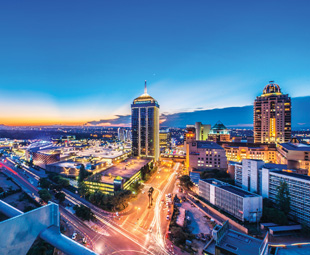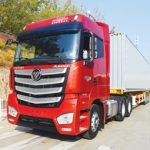Sanity in Sandton?

Is Sandton the richest square mile in Africa, or a bizarre case study in how not to move people, but rather to perpetuate inequality?
When Liberty Life first started developing Sandton City in the mid-1970s, it was hailed as the future financial capital of South Africa. The idea was to abandon the decaying central business district in Johannesburg and to create a high-image precinct, presumably “rising above the existing challenges”, to use Gautrain terminology.
Liberty seems to be satisfied with its achievements – in a recent series of advertisements it has proudly claimed that “we answered by taking a piece of farmland and building Sandton City, the cornerstone of the richest square mile in Africa”. Sadly, like the Gautrain, it has merely left many of “the existing challenges” untouched and has created a few new ones of its own.
One of the Liberty adverts happened to appear in the Business Day on February 17. On the very next page was an article by Nick Malherbe, a researcher at the University of South Africa, headed: “Water crisis exposes capitalism’s inequities”.
He may as well have been referring to traffic congestion and inefficient transport: “Little or no mention is made of climate change, or the effect big business has on it. Ecological problems such as pollution and the overuse of resources, which arise out of markets, are known as ‘externalities’. They do not impinge on production and are therefore not considered in any meaningful way by companies,” he wrote.
Sandton City and the other mini “Trump Tower” developments nearby have had a corrosive effect on traffic, energy consumption and general mobility in Sandton. Don’t forget that the real Trump Tower has five subway stations within a one-kilometre radius. Not so in Sandton, where only one Gautrain station is expected to serve Africa’s richest square mile, supported by an underperforming bus transport service.
None of this seems to bother the promoters of the Gautrain or the good burghers of Sandton, which is a popular venue for conferences and eco-mobility festivals. In February, a five-day transport conference was held at the Sandton Convention Centre, part-sponsored by the provincial government and the Gautrain. The theme was: “The Future of Public Transport: Go Green – Go Smart”.
One of the speakers was Ismail Vadi, MEC for Transport in Gauteng, whose topic was: Developing a shared vision for integrated transport systems. (When I read that nausea-inducing word “vision”, I see a bearded prophet staring into the sky, seeing angels with six wings, and creatures with the bodies of lions and heads of eagles.)
I would rather look at the reality on the ground. I planned a two-hour vigil outside the Sandton Gautrain station on February 15 to survey the low occupancy of the Gautrain feeder buses, but I soon realised that the non-Gautrain buses reflected an equally disturbing situation.
Between 06:00 and 08:05, 74 buses came past, all of them going north. There were 40 Putco buses, 28 Johannesburg Metrobuses, four Gauteng coaches and two City-to-City buses, carrying about 4 500 people in all. About 50 buses had commenced their journeys in the deep south of Johannesburg covering an average distance of around 40 km. Several buses carried standing passengers.
The slowest trip was Putco shift 9116, the 05:45 from Emdeni (Soweto) which came past at 08:05. That’s two hours and 20 minutes in the bus. So, to reach the “richest square mile in Africa”, many hapless bus passengers have to endure some harsh travelling conditions.
Three more observations: first, only one bus went south during the full two hours, which means that Sandton is nowhere close to having an all-purpose public transport service.
Second, it seems that the bus industry is going back to the converted lorries of old – there were several brand-new buses, but they had high floors, front engines and some seemed to have manual gearboxes.
Third, leaving Sandton, I passed a 2 000-strong cavalcade of single-occupant cars, many of them German Shermans and Japanese Juggernauts grinding uphill along Sandton and Grayston Drive. I’d guess that hardware worth nearly R1 billion rand was involved.
In Sandton, neither private nor public transport is either green or smart – it is merely a bizarre case study in how not to move people and how to perpetuate inequality.
Perhaps the buildings qualify for green status by virtue of growing organic lettuce on their rooftop gardens, but the congested streets outside are anything but eco-friendly.
Can we do anything about this?
One: take all the seats out of the Gautrain and let at least the Soweto passengers transfer to the train at Park Station to let them complete their journeys more quickly.
Two: create a temporary contra-flow bus lane, during the morning and afternoon peaks, along Sandton and Grayston Drives to speed up buses coming from the west.
If we continue to do nothing, remember what happened to the foolish man who built his house on sand…
Vaughan Mostert lectured on public transport issues at the University of Johannesburg for nearly thirty years. Through Hopping Off, Mostert leaves readers with some parting food for thought as he continues his push for change in the local public transport industry.
Published by
Focus on Transport
focusmagsa




